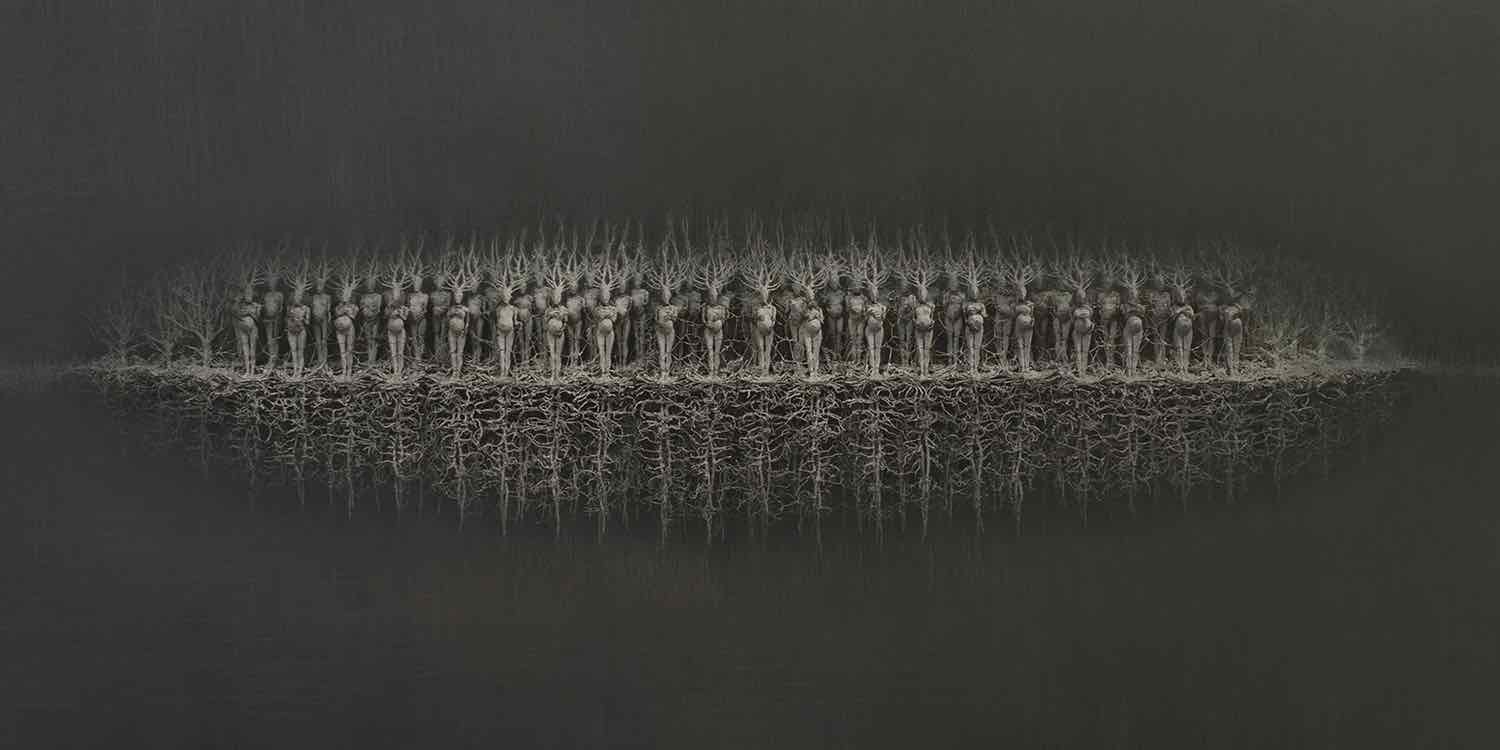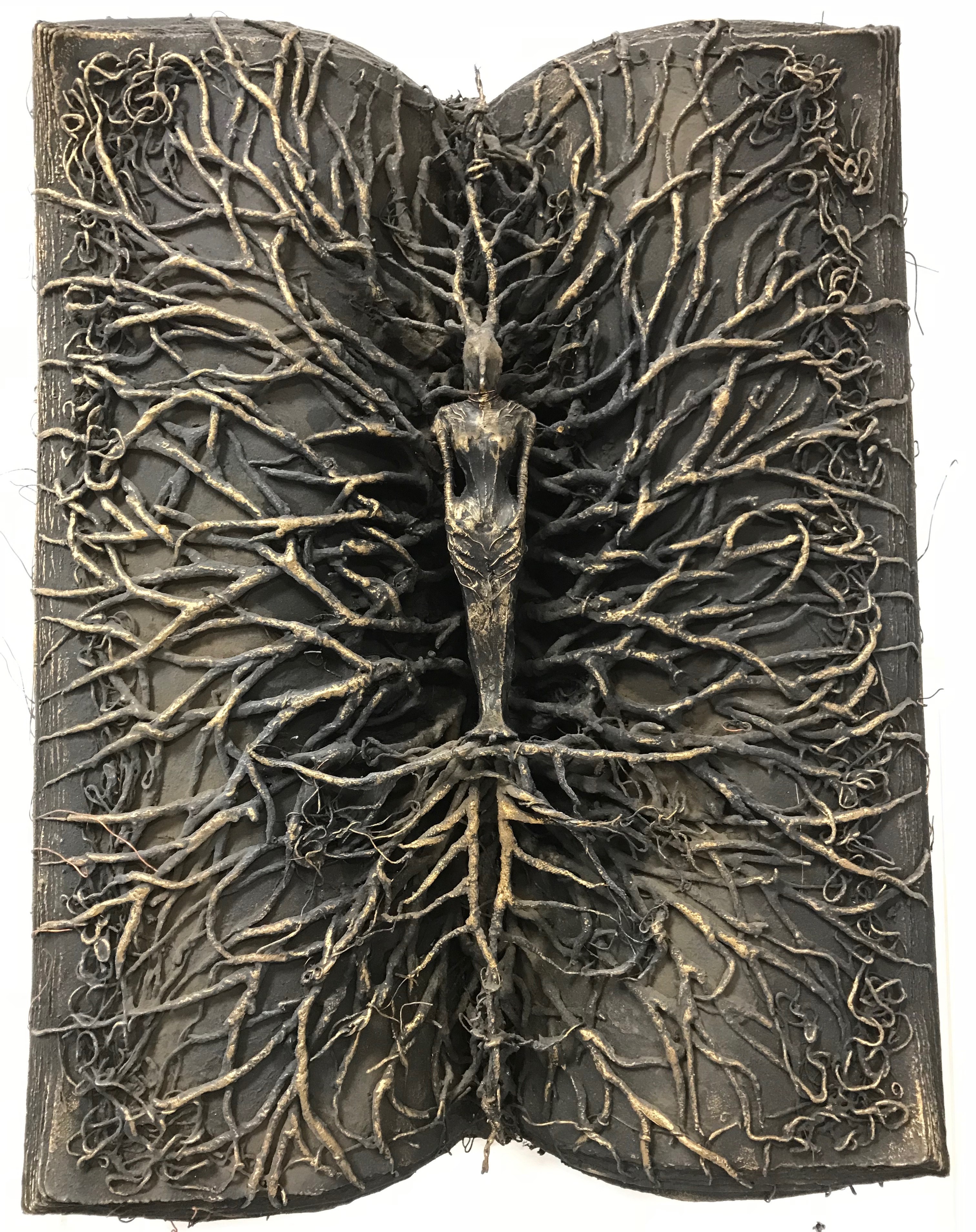
The last time I visited the sculptor Cathy de Monchaux she was holed up in her huge Peckham studio. “Was it really twenty years ago that you came to see me there?” she asks. “The commute was doing my head in, so I left,” she says bringing me her brand new spotty Bengal kitten to admire, which immediately starts attacking my shoe laces. She works, now, in her home in Hoxton Street and as the kitten does battle with my shoes, her assistant sits twisting bunches of copper fuse-wire into tree-like shapes at the kitchen table. Downstairs in her studio, where the walls are covered with large charcoal drawings and sculptural maquettes, is a big double bed covered with rich velvet drapes. “I love sleeping down here. If I’m worrying about a piece of work I can get up in the middle of the night and deal with it.”
It was soon after we met that her 1997 one person show at the Whitechapel led to a nomination for the Turner Prize. Although at Goldsmith’s during the 1980s, the same time as Damien Hirst, she was never really part of the YBA gang. Leather straps, brass and red velvet were bolted, riveted and lashed together into uncanny, erotically charged objects that borrowed their imagery equally from fairytales and the Marquis de Sade. With their spikes and festoons of black ribbons they tapped into feminist debates, at the time, around female eroticism. Embracing the burlesque they equally suggested a sense of saint-like religious rapture, with a nod to Georges Bataille’s view that: “Of all problems eroticism is the most mysterious.” Both a celebration of female sexuality, and a mirror of repressed and guilty female desire, her sculpture was profane and pagan, Gothic and theatrical, and touched on what Kristeva called the abject. Or to use the words of the poet WB Yeats, there was “a terrible beauty” about her work.

Now, as we sit and munch on our Pret sandwiches, I ask if there’s been a change in her practice, whether she’s left behind feminist debates about the body. “Well,” she replies, “as human beings and artists we change and move on. My imperatives at fifty-eight are different to those of twenty years ago. When I was younger it was an optimistic time. As women artists we thought we had an open space to do whatever we wanted. That it would all be fine. I was like, ‘Bring it on’. But twenty/thirty years later it just doesn’t feel good enough. We haven’t really arrived. Look at the #MeToo campaign. In many ways to be a feminist now is to be marginalized and side lined. And galleries have changed. I’m not represented by anyone now. I work mostly for commissions. When you’re young you’re establishing a reputation. There’s a commercial imperative to keep making work but some of my pieces take years. I’m happier now that I can work at my own pace, supported by some wonderful collectors. In many ways it gives me greater creative freedom. It’s a choice I’ve made. It’s harder and harder to be true to the work.”
“When I was younger it was an optimistic time. As women artists we thought we had an open space to do whatever we wanted”
Did she feel, I ask, that having become a mother to her son had affected her career? She thinks for a long time before answering. “I think it probably did,” she says. “It’s complicated all that juggling between work and picking up from school. I had an abortion at thirty-two, which affected me much more deeply than I could have imagined. When I got pregnant again, accidentally at thirty-nine, I knew there was no question about having the child. As to my work? Well I think the process, the rhythm, has become slower. It’s not about chasing shows any more, of producing one piece after another for a gallery.”
Looking around the studio I detect a shift from the sexualized body of her early sculptures to an exploration of the unconscious imagination. Forests abound and its not hard to see in her sculptural panoramas references to Paola Uccello’s The Hunt in the Forest, and to Shakespeare’s forest of Arden.

It’s no accident that traditionally so many fairytale characters found themselves lost in forests. At one time Europe was covered by dense woodland that presented all sorts of unknown dangers. In more modern times the forest has provided symbolism to the likes of Jung, Freud and Bruno Bettelheim to explore what lies lurking in the unconscious. Cathy de Monchaux’s forests of painted copper wire, twisted into gnarled and knotted trees, are full of half-hidden unicorns. Each is handmade and placed within these dense trees. They allude to the dreams we aspire to and can’t reach, the chivalry of mediaeval hunts and tapestries, even My Little Pony. “Art is never about just one thing,” she insists. “Good art can be read on many levels.” She also makes the point that these are threatening places that people have to cross. This very night, she reminds me, there’ll be people in Europe waiting on the edge of a forest somewhere, trying to cross a border, running for their lives, running from hunters and dogs. All these people must have their own dreams of unicorns.
The copper wire she uses for her scenarios is so thin and flexible that it’s almost like drawing in 3D. It allows her to arrange the trees however she wants and for them to stay put. Her work inhabits a territory that’s hard to define, somewhere between sculpture, drawing, painting and even needlework. In earlier scenarios she was using small female figures instead of unicorns. With their lack of features and rotund bellies they stand in rows like a female army, chthonic goddess rooted to the earth through their fecundity.

More recently she’s been embroiled with the Guardian about headline that described her new work Beyond Thinking (the title is taken from Virginia Woolf’s landmark essay “A Room of One’s Own”), commissioned for Newham College to celebrate the seventieth anniversary of the first degree ceremony for women graduates, as a “two-storey vulva”, a description which she and the college strenuously deny. “It so lacks insight and sensitivity. The college is a place of learning for women from all sort of backgrounds and faiths and it’s just an inappropriate and lazy description,” she says angrily. This towering artwork that runs up the side of the new college extension resembles, if it resembles any body part at all, a spine or back-bone, a much more apposite image for the struggles of women attempting to achieve equality through education.
“Art is never about just one thing. Good art can be read on many levels”
Cast in bronze it’s made of individual sections that reach up the side of the building. Far from being a series of vulvae, they show tiny female figures emerging from a thicket of branches laid across the pages of a book. It’s as if these tiny women are coming into being, emerging into visibility through language and learning. Forests are symbols of transformation. Boundaries between what is human and animal, plants and trees, the physical and the metaphorical world. As Duke Senior says at the beginning of Act II in As You Like It, “Our life, exempt from public haunt, finds tongues in trees, books in the running brooks, sermons in stones, and good in everything.”
Looking back over the development of De Monchaux’s work these twenty years or so, what I see is an artist who has continued to expand her vocabulary from the young woman concerned with the aesthetic resonances and politics of female sexuality, to one who is discovering new ways of being, delving deeper into the creative unconscious to explore the ongoing processes of birth, creativity, life and death.





